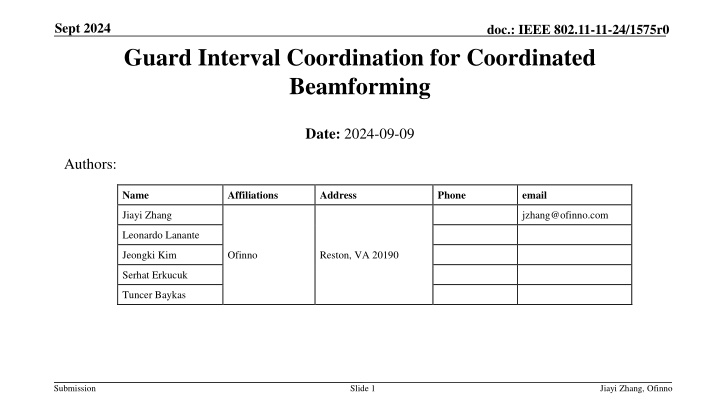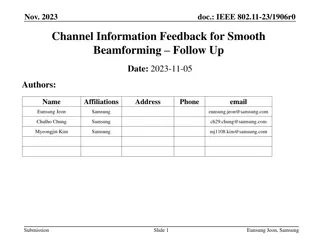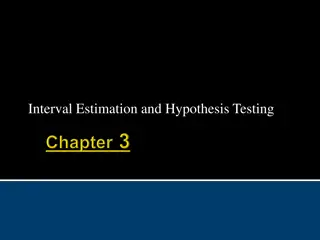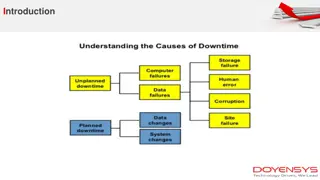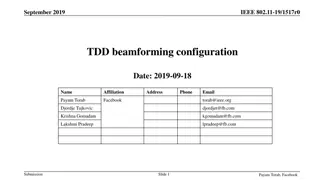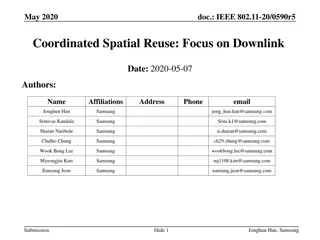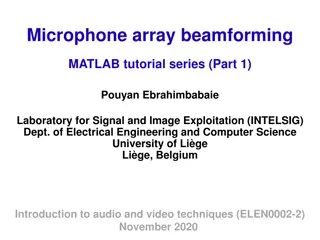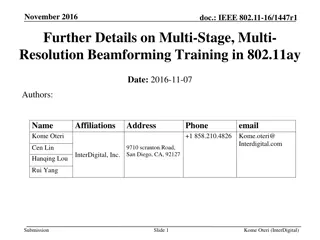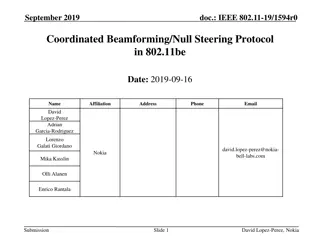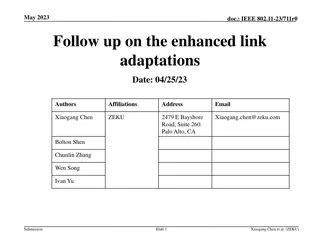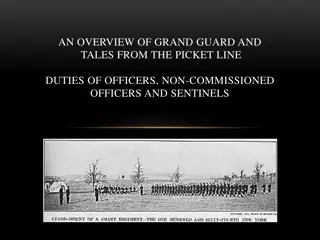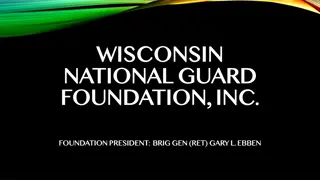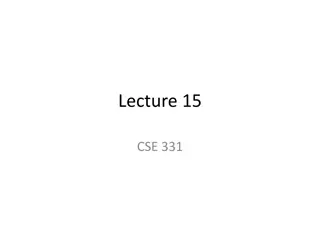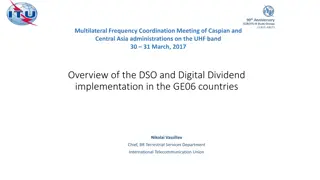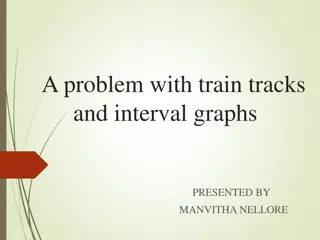Guard Interval Coordination for Coordinated Beamforming
This document discusses guard interval coordination for coordinated beamforming in IEEE 802.11 networks. It explores methods of coordination for effective beamforming strategies and transmission synchronization in multi-AP environments.
Download Presentation

Please find below an Image/Link to download the presentation.
The content on the website is provided AS IS for your information and personal use only. It may not be sold, licensed, or shared on other websites without obtaining consent from the author.If you encounter any issues during the download, it is possible that the publisher has removed the file from their server.
You are allowed to download the files provided on this website for personal or commercial use, subject to the condition that they are used lawfully. All files are the property of their respective owners.
The content on the website is provided AS IS for your information and personal use only. It may not be sold, licensed, or shared on other websites without obtaining consent from the author.
E N D
Presentation Transcript
Sept 2024 doc.: IEEE 802.11-11-24/1575r0 Guard Interval Coordination for Coordinated Beamforming Date: 2024-09-09 Authors: Name Affiliations Address Phone email Jiayi Zhang jzhang@ofinno.com Leonardo Lanante Jeongki Kim Ofinno Reston, VA 20190 Serhat Erkucuk Tuncer Baykas Submission Slide 1 Jiayi Zhang, Ofinno
Sept 2024 doc.: IEEE 802.11-11-24/1575r0 Abstract In this contribution, we discuss the guard interval (GI) used for coordinated beamforming (CBF) and propose some methods of GI coordination for the CBF. Submission Slide 2 Jiayi Zhang, Ofinno
Sept 2024 doc.: IEEE 802.11-11-24/1575r0 Background TGbn defines multi-AP Coordinated Beamforming (CBF) [1]. CBF aspects Inter-BSS/OBSS coordination set establishment and maintenance CSI acquisition from devices both in own and inter-BSS/OBSS Allocation and communication of nulling capabilities to enable concurrent transmissions without power reduction STA 2 AP 1 AP 2 STA 1 Submission Slide 3 Jiayi Zhang, Ofinno
Sept 2024 doc.: IEEE 802.11-11-24/1575r0 Background EHT MU PPDU and EHT TB PPDU define different guard intervals (GIs), e.g., 0.8 s, 1.6 s, and 3.2 s, for 1 , 2 , and 4 EHT-LTF and Data fields. Determining the GI duration required for a transmission may be based on various factors (e.g., DFT size, delay spread of CSI, and the MCS order). Example: AP1 transmits PPDU1 (e.g., with transmit beamforming TxBF) using GI1 (e.g., 0.8 s) for STA1 and PPDU2 (e.g., w/TxBF) using GI2 (e.g., 3.2 s) for STA2, respectively. AP 1 PPDU1 w/GI1 PPDU2 w/GI2 STA 1 BA STA 2 BA Submission Slide 4 Jiayi Zhang, Ofinno
Sept 2024 doc.: IEEE 802.11-11-24/1575r0 CBF using Individual GIs In a multi-AP group (or AP candidate set), AP1 is a sharing AP, and AP2 is a shared AP. AP1 and AP2 can perform multi-AP sounding to obtain CSI or beamforming feedback based on estimation by STA1 associated with and STA2 associated with AP2. AP1 and AP2 can respectively prepare beamforming steering/nulling matrix to perform CBF with STA1 and STA2. AP1 and AP2 respectively apply GI1 (e.g., 0.8 s) to PPDU1 and GI2 (e.g., 3.2 s) to PPDU2 carrying data frames for concurrent transmissions to STA1 and STA2. However, different lengths of GIs, i.e., GI duration, in PPDUs may cause issue in PPDU-level synchronization during the concurrent transmission. Multi-AP trigger PPDU1 w/ GI1 AP 1 PPDU2 w/ GI2 Multi-AP Sounding AP 2 BA STA 1 BA STA 2 Submission Slide 5 Jiayi Zhang, Ofinno
Sept 2024 doc.: IEEE 802.11-11-24/1575r0 CBF using Uncoordinated GIs A sharing (e.g., AP1) sends to a shared AP (e.g., AP2) a trigger frame (e.g. MAP trigger) to initiate a MAP transmission. The trigger frame indicates a GI duration to be used by the sharing AP and AP2 for DL transmission to STA1 and STA2. AP1 chooses the GI duration or the GI type based on local information of AP1. AP1 further decides the GI indicated in the trigger frame based on a GI duration required for transmitting a data frame to STA1. AP1 and AP2 concurrently send PPDU1 and PPDU2 for data transmissions using the GI indicated in the MAP trigger frame. However, as the selected GI indicated in the trigger frame is shorter than required to transmit/receive the data frame transmitted by AP2, STA2 experiences inter-symbol interference (ISI) while receiving the PPDU2 from AP2. Multi-AP trigger (GI1) PPDU1 w/ GI1 AP 1 PPDU2 w/ GI1 Multi-AP Sounding AP 2 BA STA 1 BA STA 2 Submission Slide 6 Jiayi Zhang, Ofinno
Sept 2024 doc.: IEEE 802.11-11-24/1575r0 CBF using Coordinated GI A sharing AP (e.g., AP1) and a shared AP (e.g., AP2), within a multi-AP group, may broadcast beacon frames exchanging capability information of supporting GI coordination. After multi-AP sounding, AP2 transmits to AP1 a frame (e.g., notification) indicating a GI1 that AP2 intends to use for a data transmission to STA2 during a TXOP of AP1. Multi-AP trigger (GI2) PPDU1 w/ GI2 Alternatively, AP1 transmits to AP2 a frame (e.g., request) soliciting the GI1 that AP2 intends to use. AP1 transmits to AP2 a trigger frame (e.g., MAP trigger) indicating a GI2 for the data transmission of PPDU2 to STA2, where the GI2 is based on the GI1. Both AP1 and AP2 apply the GI2 to PPDU1 for the data transmission to STA1 and PPDU2 for the data transmission to STA2, respectively. Ack AP 1 Notification /GI1 PPDU2 w/ GI2 Multi-AP Sounding AP 2 BA STA 1 BA STA 2 Submission Slide 7 Jiayi Zhang, Ofinno
Sept 2024 doc.: IEEE 802.11-11-24/1575r0 Summary In this contribution, we shared some thoughts of GI coordination for CBF. Submission Slide 8 Jiayi Zhang, Ofinno
Sept 2024 doc.: IEEE 802.11-11-24/1575r0 References 1. 2. 3. 4. 5. 6. 7. 8. 9. 10. 11-24/0454, Multi-AP Sounding, Xiaofei WANG (InterDigital) 11. 11-23/0084, Considerations on Multi-AP Operation - Follow Up, Jiayi Zhang (Ofinno) 12. 11-23/2009, Multi-AP for reliability with Coherent and Non-coherent transmissions, Yanchun Li (Huawei) 13. 11-20/0099, Coordinated Beamforming for 802.11be, Roya Doostnejad (intel) 14. 11-19/1594, Coordinated Beamforming/Null Steering Protocol in 802.11be, David Lopez-Perez (Nokia) 15. 11-19/0638, Nulling and coordinated beamforming, Sigurd Schelstraete (Quantenna) 11-24/0209, Specification Framework for TGbn 11-24/0880, CBF Recap and Way Forward, Okan Mutgan (Nokia) 11-24/0142, Residual Interference in CBF, Dana Ciochina (Sony) 11-24/1204, Coordinated Beamforming for 11bn, Insik Jung (LGE) 11-24/1211, Coordinated BF Goodput Discussion, Genadiy Tsodik (Huawei) 11-24/0010, Coordinated Beamforming for 802.11bn, Okan Mutgan (Nokia) 11-24/0444, Considerations on Joint Transmission, Kazunobu Serizawa (ATR) 11-23/1843, Multi-AP Joint Transmission Simulations with Impairments, (Maxlinear Inc) 11-24/1092, Multi-AP Coordinated Concurrent Transmission Protocol, Kosuke Aio (Sony) Submission Slide 9 Jiayi Zhang, Ofinno
